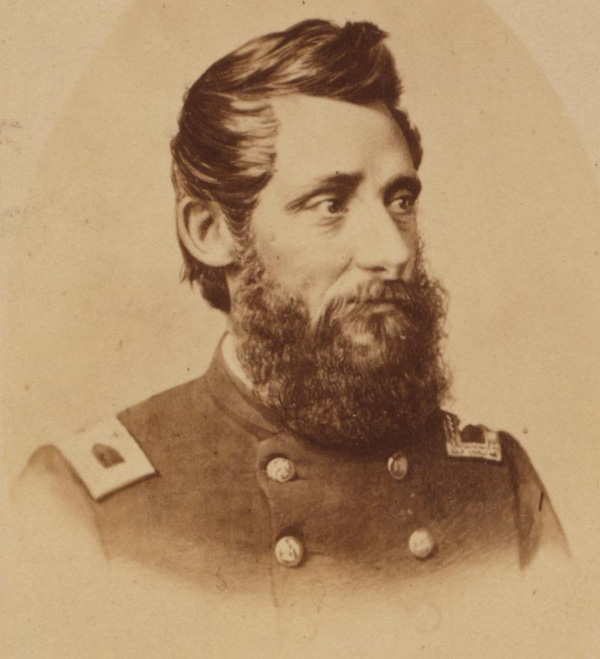 Benjamin H. Grierson from the Civil War Photograph Collection, Library of Congress
Benjamin H. Grierson from the Civil War Photograph Collection, Library of Congress
Submitted by Rich Harrison
The popular pastime of "geocaching" consists of an individual hiding a container and giving the coordinates to seekers, who then use a GPS or phone app to locate it. Once located, they open the container and sign the log with the date it was found.
There is a cache here in Central along the trail of a historic route of a Civil War cavalry raid called "Grierson's Raid." It was called by General U.S. Grant the most successful raid of the war, as it played a direct role in the success of the Vicksburg campaign. It tied up the majority of the Confederate calvary in Mississippi. It was also the only cavalry raid to carry a large cavalry force through 600 miles of hostile territory in the heart of the Confederacy.
The raid started in LaGrange, Tennessee April 17, 1863 with 1700 horse troops and a battery of (6) 2 pound cannon. Their goal was to destroy the Southern Railroad's Meridian-Vicksburg line at Newton Station in Central Mississippi. This they did successfully with only a Mississippi map and a compass for navigation.
Twice they crossed waist deep swamps. They were probably going in a straight line toward their destination, and they did return via other routes missing the swamps.
After the destruction of the rail line and depot, Colonel Benjamin H. Grierson was to return to Union lines the best way he could. As Confederates were north of him, Grierson left Newton going southeast to misdirect followers. He actually planned to go to Port Gibson to help Grant with the Vicksburg campaign. At Union Church, his scouts determined the majority of the Confederate cavalry were west of Union Church, waiting to ambush Grierson's troops. Grierson then decided to go south to Baton Rouge, which was in Union hands. He completed his raid in 16 days, on May 2, 1863, in Baton Rouge with 5000 Confederate troops all across the Mississippi River trying to capture him. Some were only 2 hours behind as he crossed the Comite River into Baton Rouge.
Grierson lost 3 dead, 7 wounded, and 9 men reported as missing on the raid. The raiders killed and wounded over 100 Confederate soldiers, captured 500, most of whom were paroled. The raiders destroyed over 50 miles of railroad line, destroyed 3 depots, and captured 1000 horses and mules. At one point, they passed through the town of Raleigh. They gave chase to one man who grabbed his horse and galloped away. He was caught and found to be the Sheriff. His saddle bags were full of Confederate money – the county treasury. He was released and the funds retained, reported to later have been used to pay locals for food for the troops and their mounts.
Day 16, May 2, 1863, was the last day of the raid. Dawn found the troopers still in their saddles riding toward the Comite River and safety. Many troopers fell asleep only to awaken when their mount stopped to rest or graze. The Comite's best fording place was guarded by one company of Confederates. Grierson decided a "sabers drawn" charge into the camp from both sides would be best to dislodge the defenders. This worked better than anticipated and resulted in 42 prisoners. Being the last day of the march, these were not paroled but joined the march as prisoners of war. They were now only 9 miles from the Federal picket line guarding Baton Rouge.
For geocachers: this site is located at N 30 degrees, 331.960 W 091 degrees, 05.498. It is a large jar. More information can be found on Geocaching.com at "Grierson's Raid – Comite River" (GC2W7PV). The trail will have various size and type caches at sites on the route covered by the raiders. For the history buff it will also include some diversionary trails used by the Raiders to misdirect those following them. The posting for each will highlight the historic nature of each site. For example, there is a cache at the town of Raleigh mentioned above, as well as one at the "lost town" of Westville. This will be a trail in process, so watch for new caches as they are placed. Some locations mentioned in the history are not on most maps and may or may not get caches. Interesting trivia; the John Wayne movie "Horse Soldiers" was loosely based on this raid. References used: "A Just and Righteous Cause: Benjamin H. Grierson's Civil War Memoir" and "Grierson's Raid" by Tom Lalicki.
0 comments